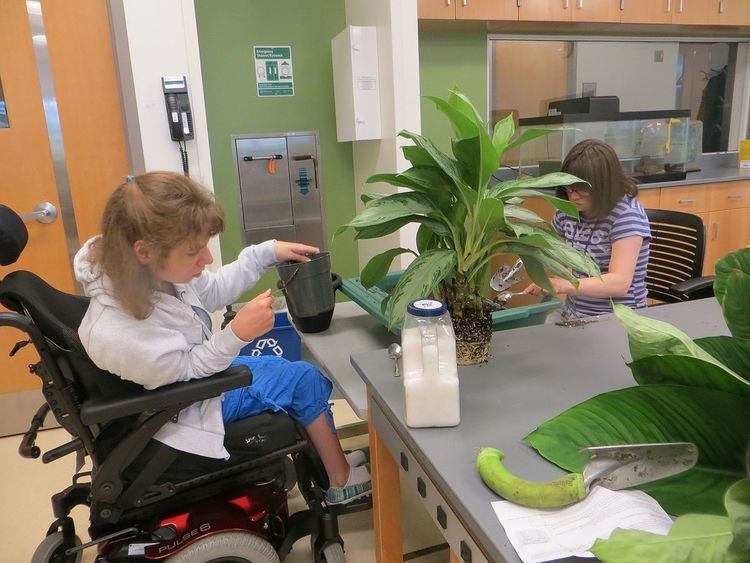 | ||
Horticultural therapy (also known as social and therapeutic horticulture or STH) is defined by the American Horticultural Therapy Association (AHTA) as the engagement of a person in gardening and plant-based activities, facilitated by a trained therapist, to achieve specific therapeutic treatment goals. The visual aesthetics of plants are known to elicit feelings of inner peace, which generates positive emotions toward a meaningful appreciation of life. Direct contact with plants guides the individual's focus away from stress enhancing their overall quality of life. The AHTA believes that horticultural therapy is an active process which occurs in the context of an established treatment plan. Horticultural therapists are specially educated and trained members of rehabilitation teams (with doctors, psychiatrists, psychologists, occupational therapists and other) who involve the client in all phases of gardening, from propagation to selling products, as a means of bringing about improvement in their life.
Contents
History
According to the American Horticultural Therapy Association, Ancient Egyptian physicians prescribed walks around a garden for patients with mental illness; which makes the first sign of the therapeutic process in Alexandria and Ancient Egypt through Renaissance Europe. During the Middle Ages, on the grounds of a monastery hospital, plants were used to express purpose of cheering up melancholy patients. Also, the gardens were used to treat both physical and mental ailments of sickness who visited them. The first modern documentation of horticulture being used as a treatment for mental health purposes was in the 1800s. Dr. Benjamin Rush discovered that field labor in a farm setting helped attain positive outcomes for clients with mental illness (Simson & Straus, 2003). This discovery lead many hospitals in the western world to begin using horticulture as a means to start therapeutically treating patients with mental health and developmental disabilities. In 1817, the Asylum for Persons Deprived of Their Reason, now known as Friends Hospital, constructed an environment with landscaping, paths and a park atmosphere in effort to assist patients in their recovery. In 1879 Friends Hospital built the first greenhouse that was used for therapy (Simson & Straus, 2003). “During World War I and II, servicemen worked in gardens to improve functioning of injured limbs and increase mental function, but also to learn new skills and to provide food” (http://tiadjones.tripod.com/horttherapy.htm#d). Plants and gardening also came to be used as a diversion for those who were hospitalized long-term.
The 1950s and 1960s brought the first degree in horticultural therapy at Michigan State University. In 1972, Kansas State University created the first curriculum that provided students with dual training in both psychology and horticulture (Simson & Straus, 2003). The first graduate degree program was offered by Clemson University in 1973 (Simson & Straus, 2003). In 1973 the Council for Therapy and Rehabilitation though Horticulture (NCTRH) was established by a group of horticulture therapy professionals. In 1988, they changed their name to the American Horticulture Therapy Association (AHTA) which they are still called today. AHTA is a non-profit organization with about 25% off their members being professionally registered
Credentials
American Horticulture Therapy Association (AHTA) offers the opportunity for professionals interested in practicing horticultural therapy to register as Horticultural Therapists (Horticulture Therapy Registered, HTR). Some colleges and universities have academic programs in horticulture therapy that are accredited through AHTA. AHTA has a set core curriculum for accredited programs to follow. Along with specific classes to take, internships are a very critical component. AHTA requires that to be Horticultural Therapist Registered, 480 hours of field experience are to be completed.
Programs
Horticultural Therapy can be used with a variety of populations and settings. Simson and Straus (2003) have categorized Horticultural Therapy services into three main types of programming; vocational, social, and therapeutic. Clients benefiting from the therapeutic arm of Horticultural Therapy typically include those individuals with psychiatric challenges, substance abuse issues, and those who are in recovery from a physical injury. Clients served under the vocational arm of Horticultural Therapy may include individuals who are incarcerated, have a developmental or psychiatric disability, or people who have experienced socioeconomic disadvantages. Clients typically served under the social arm of Horticultural Therapy might include the elderly, and community-based programs.
Benefits from such programs vary from physical improvements, positive mental health, and community based involvement. Horticulture therapy can have positive effects on your body including, a lower blood pressure, a reduced need for medical treatment, and promoting a more heathy physic. Psychological changed have always been seen in previous Horticulture therapy patients. Patients suffering from a variety of diseases proved to benefit mentally from simply the views from nature, and being out doors around the plants. Thirdly, as far as the community aspect, patients suffering from mental illness can benefit simply from gardening because it forces them into a community of others who are interested in the same hobby. Gardening can be done in groups, and many times therapy groups are created in order to promote this idea of community based health and wellness.
